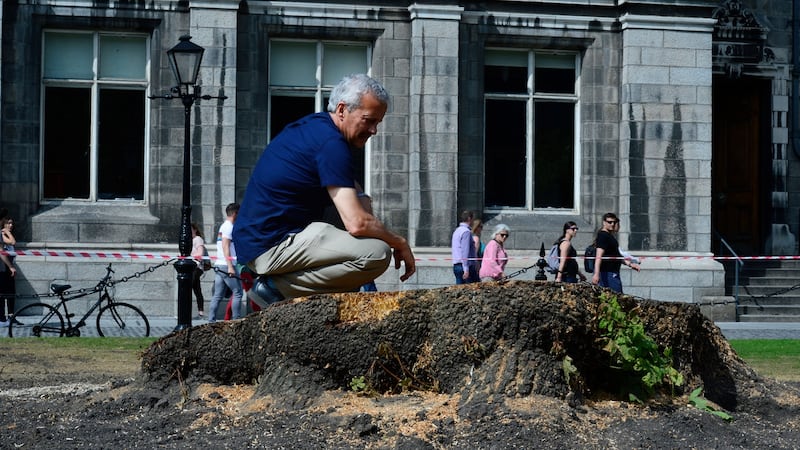Stress is the probable cause of death of the majestic 170-year-old Oregon Maple tree, which "catastrophically and unexpectedly" collapsed last Saturday on the grounds of Trinity College in Dublin.
Tree stress is not quite the same as the human variety but, in much the same way a weak immune system may facilitate infection, the great maple was struggling because of it, according to Professor of Systematic Botany in Trinity College John Parnell.
“We simply do not know, and probably will never know, why this maple in Library Square collapsed at the time it did. It is probable it was at least in part due to the very hot weather causing exceptional physiological and physical stress for a tree that was not in tip-top condition.”
Two other Oregon Maples on campus were subsequently examined. One in New Square was removed on Tuesday in light of Saturday’s incident, though it had been due to be cut down because it was diseased.
Oregon Maples are native to the Pacific northwest of America and occur generally in wet areas there. It is unlikely air pollution played a part in the demise of the Library Square maple, as it was a deciduous tree and not vulnerable to such threats, Prof Parnell said.
Word of the tree’s collapse was widely shared on social media. That sense of collective sadness at the death of a landmark tree was also reflected in the response Prof Parnell got to an email he sent out, as chair of Grounds and Gardens Advisory Committee, in which he outlined to students and staff the circumstances of the tree’s death.
“On a personal basis, I am genuinely sad to see it go. I also feel sorry for the campus services staff of the university [who] have spent a lot of time and put a lot of effort into ensuring that the tree was around for as long as possible.”
He was “more surprised than most people” that the tree, the backdrop to thousands of graduation photographs, had collapsed.
Trinity frequently gets trees surveyed by international experts, Bartlett. The latest survey, in April, raised concerns about the condition of all three Oregon Maples on campus. It was not believed, however, that any were in immediate danger of collapse. And the hope was that their lives could be prolonged by remedial work.

Techniques such as tomography (a form of ultrasound scan) are used to assess tree condition, providing coloured images of sections through the trunk or branches.
Using this technique Bartlett showed a large amount of dead or damaged wood on the northwest side of the trunk of the Maple in New Square, as only a third of the trunk at this level was solid wood. In-house tree pathologist Paul Dowding and Bartlett confirmed the presence of two different wood-decaying fungi.
TCD is unaware who planted the Library Square Maple or precisely when. There appears to be a range of possibilities.
Although seed was first sent back to England from the US in about 1812 by naturalist Archibald Menzies, Prof Parnell believed this source was unlikely.
This species was introduced to Britain for cultivation purposes by botanist and explorer David Douglas (of Douglas Fir fame) who sent seeds to the Royal Horticultural Society in London in 1827.
"As far as I know, all the oldest remaining specimens in Britain date from this. Douglas knew, met and probably worked with [Irish botanist] Thomas Coulter in Monterey, California. Coulter became the first curator of the TCD herbarium in 1840 and so the plantings may date from then," he said.
Alternatively, William Henry Harvey, Coulter's successor, may have planted them following his visit to North America in 1849. "To be honest, we really don't know but if we can count the tree rings in the remaining stump that might give us the answer to the when [it was planted]," said Prof Parnell.









